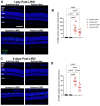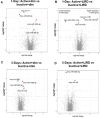This is a preprint.
Forced exercise modulates retinal inflammatory response and regulates miRNA expression to promote retinal neuroprotection during degeneration
- PMID: 40777372
- PMCID: PMC12330557
- DOI: 10.1101/2025.07.16.665187
Forced exercise modulates retinal inflammatory response and regulates miRNA expression to promote retinal neuroprotection during degeneration
Abstract
Background: Our labs have demonstrated exercise is protective in animal models of retinal degeneration (RD). Inflammation drives RD progression, and is regulated by the recruitment and reactivity of glia cells as well as through small non-coding RNAs, microRNAs (miRNAs). Here, we explore the effects of treadmill exercise on the recruitment and reactivity of retinal inflammatory cells within the neural retina and miRNA expression in a light-induced retinal degeneration model (LIRD) that exhibits phenotypes found in patients with RD.
Methods: Male 6-week-old BALB/c mice were randomly assigned to either active or inactive groups. Active groups were exercised by treadmill 1 hour a day for two weeks at a speed of 10m/min, meanwhile inactive groups were placed on static treadmills for the same duration. Light induced retinal degeneration (LIRD) was induced during the second week of exercise using light exposure of 5000 lux, control animals were kept at 50 lux. Retinal function was assessed using electroretinography (ERG) 5 days after LIRD. Retinas were collected 1-day and 5-days post-LIRD, sagittal sections were stained for inflammatory markers (GFAP and Iba1), TUNEL (cell death), and photoreceptor nuclei (outer nuclear layer; ONL) were quantified. RNA was extracted and miRNA expression quantified with GeneChip miRNA 4.0 array.
Results: Active+LIRD mice demonstrated significant preservation of retinal function, evidenced by higher a-wave and b-wave amplitudes in ERG 5-days post-LIRD, compared to inactive+LIRD mice. Retinal sections from active+LIRD mice had fewer Iba1+ cells and decreased GFAP labeling 5-days post-LIRD compared to inactive+LIRD mice. Active+LIRD mice had fewer ONL TUNEL+ cells compared to inactive+LIRD mice. Inactive+LIRD mice showed a decline in ONL counts 1-day post-LIRD with significant loss 5-days post-LIRD compared to active+LIRD mice. In active groups, exercise promoted significant differences in miRNA expression, such as miR-302b, miR-192-5p, miR-187 compared to inactive groups.
Conclusions: Our results indicate that treadmill exercise preserved photoreceptor density, slowed and or prevented apoptosis in the ONL, and decreased the presence/recruitment of inflammatory cells in the neural retina. Altered miRNA expression profiles in active groups are associated with cell survival (miR-302b), oxidative stress regulation (miR-192-5p) and photoreceptor homeostasis (miR-187). These results reveal how exercise alters the retinal inflammatory response over the course of 1-day to 5-days, providing insight into exercise-based therapies and treatments for RD and neuroinflammatory diseases.
Keywords: Exercise; Retinal Neuroprotection; Retinal inflammation; miRNA.
Conflict of interest statement
Competing interests Not applicable.
Figures






References
Publication types
Grants and funding
LinkOut - more resources
Full Text Sources
Miscellaneous
